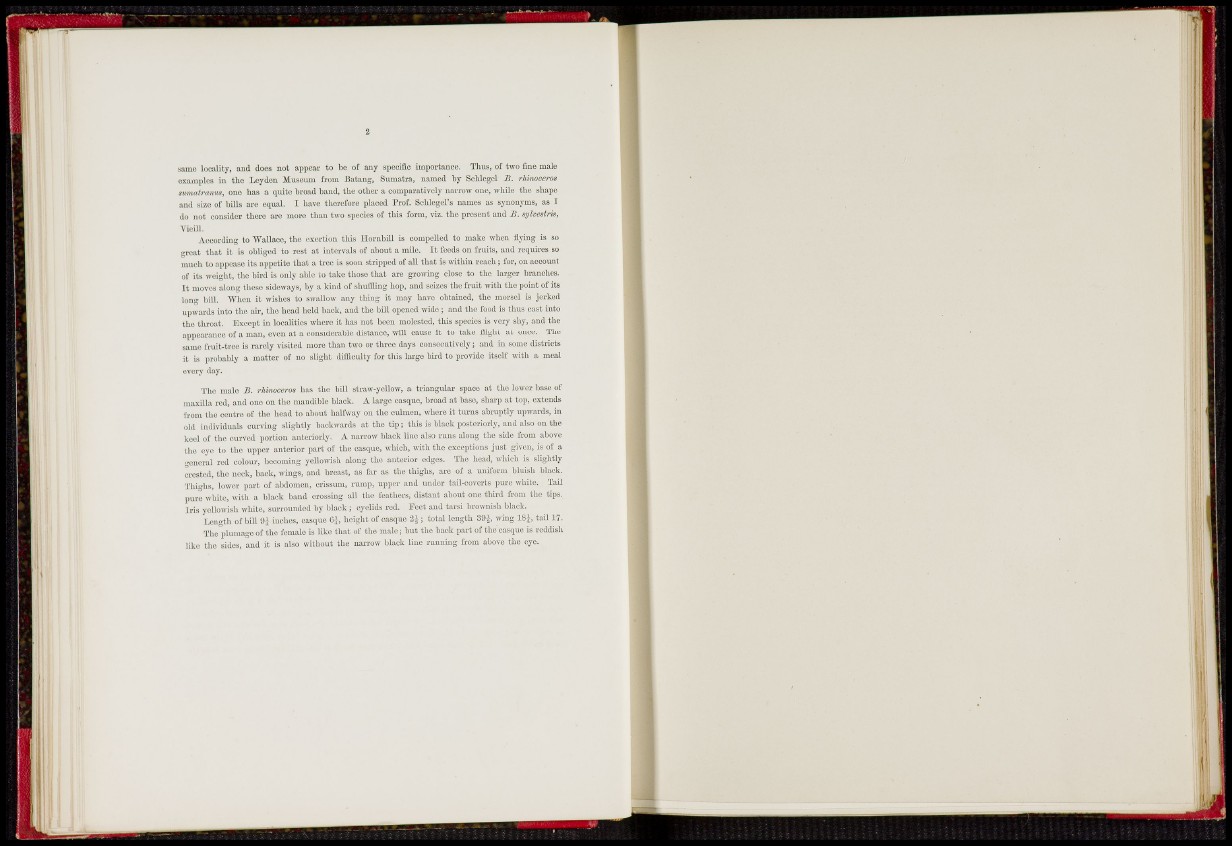
same locality, and does not appear to be of any specific importance, Tims, of two fine male
oxamplüb iu the Leyden Museum from Batang, Sumatra, named by ScUegel B. rhinoceros
amialranus, one has a quite broad band, the other a comparatively narrow one, while the shape
and size of bills are equal. I have therefore placed Prof. Schlcgel's names as synonyms, as I
do not consider there arc more than two species of this form, viz. the present and B. sylvestris,
Vioill.
According to Wallace, the exertion this llornbill is compelled to make when flying is so
great that it is obliged to rest at intervals of about a mile. It feeds on fruits, and requires so
much to appease its appetite that a tree is soon stripped of all that is within reach; for, on account
of its weigiit, the bird is only able to take those that are growing close to the larger branches.
I t moves along these sideways, by a kind of shuffling hop, and seizes the fruit with the point of its
long bill. When it wishes to swallow any thing it may have obtained, the morsel is jerked
upwards into the ah-, the head held back, and the bill opened wide; and the food is thus cast into
the throat. Except in localities where it has not been molested, this species is very shy, and the
appearance of a man, even at a considerable distance, wUl cause it to take flight at once. The
same fruit-tree is rarely visited more than two or three days eonsecutivcly; and in some districts
it is probably a matter of no slight difficulty for tliis large bird to provide itself -with a meal
every day.
The male B. rhinoceros has the bill straw-yellow, a triangular- space at the lower ])ase of
maxilla red, and one on the mandible black. A large casque, broad at base, sharp at top, extends
I'rom the centro of the head to about halfway on the culmen, where it turns abruptly upwards, in
old individuals curving slightly backwards at the tip; this is black posteriorly, and also on the
keel of the curved portion anteriorly. A narrow black line also runs along the side from above
the eye to the upper anterior part of the casque, which, \vith the exceptions just given, is of a
general red coloui-, becoming yellowish along the anterior edges. The head, which is slightly
crested, the neck, back, wings, and breast, as far as the thighs, are of a uniform bluish black.
Thighs, lower pai't of abdomen, crissum, rump, upper and under tail-coverts pure white. Tail
pure white, Avith a black band (grossing all the feathers, distant about one third from the tips.
Iris yellowish white, surrounded by black; eyelids red. J?eet and tarsi brownish black.
Lcngtli of biU inches, casque d h height of casque ; total length wing 18^, tail 17.
The plumage of the I'emale is like that of the male; but tlie back part of the casque is reddisii
like the sides, and it is also without the narrow black line running from above the eye.